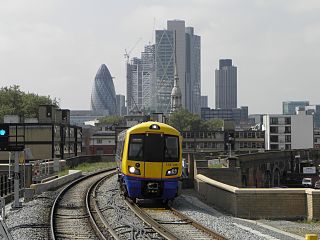
The East London line is part of the London Overground, running north to south through the East, Docklands and South areas of London. It was previously a line of the London Underground.

Peckham is a district in south-east London, within the London Borough of Southwark. It is 3.5 miles (5.6 km) south-east of Charing Cross. At the 2001 Census the Peckham ward had a population of 14,720.

The Northern City Line is a commuter railway line in England, which runs from Moorgate station to Finsbury Park in London with services running beyond. It is part of the Great Northern Route services, and operates as the south-eastern branch of the East Coast Main Line (ECML). It is underground from Moorgate to Drayton Park in Highbury, from which point it runs in a cutting until joining the ECML south of Finsbury Park. Its stations span northern inner districts of Greater London southwards to the City of London, the UK's main financial centre. Since December 2015, its service timetable has been extended to run into the late evenings and at weekends, meeting a new franchise commitment for a minimum of six trains per hour until 23:59 on weekdays and four trains per hour at weekends.

The South London line is a railway line in inner south London, England. The initial steam passenger service on the route was established by the London, Brighton and South Coast Railway (LBSCR) on 1 May 1867 when the central London terminal stations of Victoria and London Bridge were connected to the inner south London suburbs of Battersea, Clapham, Brixton, Camberwell and Peckham. A pioneer of overhead electric traction, most of the line was built on high level viaducts and was marketed as the South London Elevated Electric Railway in the early part of the 20th century. The electric service was popular, with four trains per hour and 12 million passengers in 1920. Between Wandsworth Road and Peckham Rye the route ran parallel to another set of tracks. Prior to 1923, both lines from Wandsworth Road to East Brixton were owned by the London, Chatham and Dover Railway (LCDR) and the lines from East Brixton to Peckham Rye were owned by the LBSCR. The southern Atlantic lines were operated by the LBSCR and the northern Chatham lines were operated by the LCDR.

Surrey Quays is a station on the East London Line of the London Overground. It is located in Rotherhithe, part of London Borough of Southwark; it is in Zone 2. The next station to the north is Canada Water; to the south, it splits into branches to Clapham Junction, New Cross and Crystal Palace/West Croydon. Closed in late 2007 as an underground station, it was refurbished and reopened as part of the London Overground network on 27 April 2010.
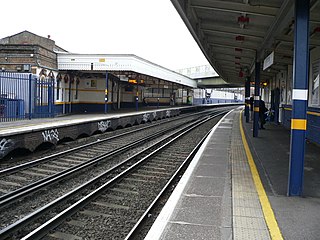
Brixton railway station is a commuter railway station in Brixton, South London, UK. It is on the Chatham Main Line, 3 miles 14 chains (5.1 km) down the line from London Victoria. Trains are operated by Southeastern. The typical service is one train every 15 minutes in both directions, from Victoria to Orpington via Bromley South.

South Bermondsey railway station is on the South London line, serving the district of South Bermondsey in the London Borough of Southwark and managed and operated by Southern. It is 1 mile 63 chains (2.9 km) down the line from London Bridge; the following station on the line is Queens Road Peckham. The station is the principal stop for Millwall F.C.'s The Den.
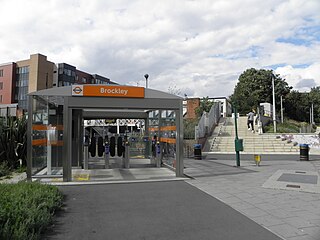
Brockley railway station serves the south-east London district of Brockley and is on the main railway line between London Bridge and Brighton. It is 3 miles 56 chains down the line from London Bridge.

Peckham Rye is a railway station in Peckham town centre, South London. The station is served by Southern, London Overground, Southeastern and Thameslink.
There have been two separate generations of trams in London, from 1860 to 1952 and from 2000 to the present. There were no trams at all in London between 1952 and 2000.
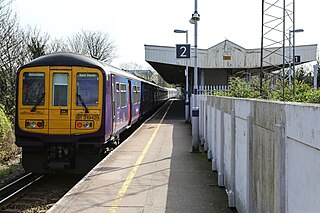
Nunhead railway station is in the Nunhead area of the London Borough of Southwark. It is 5 miles 77 chains (9.6 km) measured from London Victoria. The station is managed by Thameslink. It is in Travelcard Zone 2.

The Crystal Palace and South London Junction Railway was authorised to build a line from Peckham Rye railway station to a terminus at Crystal Palace in 1862, in order to serve the attraction of the Crystal Palace.

London Buses route 3 is a Transport for London contracted bus route in London, England. Running between Crystal Palace and Victoria bus stations, it is operated by Transport UK London Bus.

Hoxton is a station on the East London line in the London Borough of Hackney, Greater London. It is on the Kingsland Viaduct and served by London Overground. The station entrance is on Geffrye Street near Dunloe Street and Cremer Street, behind the Museum of the Home.

London Overground is a suburban rail network serving London and its environs. Established in 2007 to take over Silverlink Metro routes, it now serves a large part of Greater London as well as Hertfordshire, with 113 stations on the six lines that make up the network.

London has an extensive and developed transport network which includes both public and private services. Journeys made by public transport systems account for 37% of London's journeys while private services accounted for 36% of journeys, walking 24% and cycling 2%,according to numbers from 2017. London's public transport network serves as the central hub for the United Kingdom in rail, air and road transport.

The Crystal Palace and South London Junction Railway (CPSLJR) was built by the London, Chatham and Dover Railway (LCDR) from Brixton to Crystal Palace High Level to serve the Crystal Palace after the building was moved to the area that became known as Crystal Palace from its original site in Hyde Park.
Honor Oak railway station was a station opened in December 1865 in Honor Oak, London by the London, Chatham and Dover Railway on the Crystal Palace and South London Junction Railway. The line was built to carry passengers to The Crystal Palace after its move from Hyde Park. The station featured two wooden platforms, and apart from two brief closures during World War I and World War II, it remained open until 1954 when the entire branch line was closed. The station was demolished around 1956–7 and afterwards the site has been redeveloped with housing.
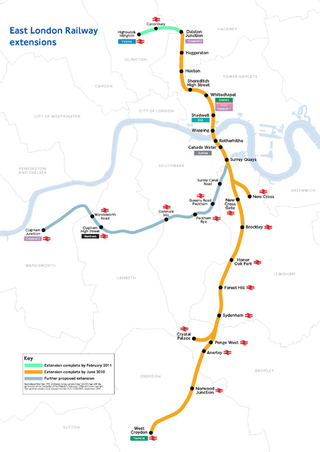
The East London line extension (ELLX) project was a British railway engineering project in London, managed by Transport for London. The project involved extending the East London Line and making it part of the mainline London Overground network. This was done by re-opening sections of disused railway line and by converting track electrified by the third-rail system, signalling, lineside signage and communication systems, etc. to mainline standards. New rolling stock was introduced and four new stations built along the route, with a fifth scheduled to be added in the future at New Bermondsey.

The London Night Bus network is a series of night bus routes that serve Greater London. Services broadly operate between the hours of 23:00 and 06:00.


















